| | Sugar performs a variety of functions in food products. In addition to providing a sweet taste and flavour, sugar is used as a preservative in products such as jams and jellies and inhibits the growth of micro-organisms. Sugar is used in baked goods to hold moisture and prevent staleness. In canned fruits and vegetables, sugar enhances texture and colours. It is also used to prevent large ice crystals from forming in frozen sweet mixtures such as ice cream and support fermentation in products containing yeast, such as bread. Considering all of these roles, sugar is an important and versatile food ingredient.
Canada’s sugar industry is a small player in the world market; however, Alberta’s beet sugar industry plays an important role in Canada’s broader sugar industry. This issue looks at the Canadian sugar market with a special emphasis on Alberta’s market.
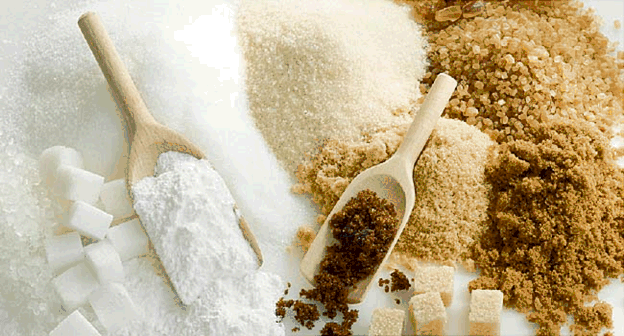
Source: https://www.webmd.com/diet/rm-quiz-sugars-sweeteners
What Sugar Is Made Of?
Sugar refers to sucrose, a carbohydrate found naturally in most fruits and vegetables. Sucrose occurs in the greatest quantities in sugar cane and sugar beets, which are used to produce sugar for use at home and in food products. The process of extracting and purifying sugars from sugar cane and sugar beets (Figure 1) allows for the production of a large variety of sugars.
Canada's Food and Drug Regulations require that "sugar" meet the standard of at least 99.8 per cent pure sucrose. This is distinct from all other sweeteners including high-fructose corn syrup, maple syrup, and honey, as well as non-caloric sweeteners that are regulated as food additives. Sugars may differ in colour, flavour, sweetness and crystal size. Each of these characteristics allows sugar to perform a variety of functions in food products, in addition to providing a sweet taste.
Figure 1: The process of extracting and purifying sugars from sugar cane and sugar beet
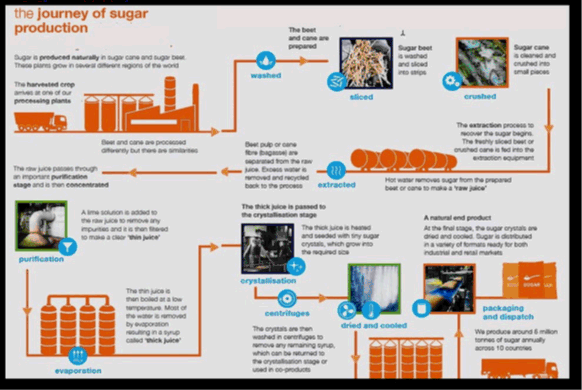
Source: AB Sugar, an Introduction to Global Sugar Market, 2017
Different Sugars
.As mentioned above, the process of extracting and purifying allows for a variety of sugars. Some of them include:
Granulated sugar — This type of sugar (pure sucrose) is naturally white. No bleaching agent is added at any time during the refining process. This is the most common form of sugar used in households and commercial food products. It is available in a number of different crystal sizes.
Icing sugar — Powdered granulated sugar with a touch of cornstarch (gluten-free) added to prevent caking that would otherwise occur when icing's very fine particles absorb moisture from the air.
Brown sugars — Often referred to as “soft sugars,” brown sugars are produced by crystallizing the golden colored syrup or by mixing molasses syrups with pure white sugar crystals.
Liquid sugar — Includes liquid sugar and liquid inverted sugar, which are predominantly produced in industrial quantities for use by food manufacturers.
Specialty sugars — Includes Demerara-style, “Plantation Raw,” Organic, and Golden Syrup.
Consumer Market Trends For Sugar
According to Statistics Canada’s food disappearance data, per-capita availability of refined sugar has been decreasing in Canada. Disappearance data is useful in analyzing the long-term trends in sugar availability, but do not give actual sugar consumption. The reason is that sugars used in food processing and wastage occurs at the retail, restaurant/institutional and household levels, including cooking, storage, and plate losses, as well as non-food usage of sugars are not adjusted. Therefore, this data does not represent the actual consumption. However, when adjusted for losses, the figures provide a reasonable estimation. As illustrated in figure 2, between 2000 and 2016, per-capita sugar availability decreased from 24.6 kg to 17.2 kg per person per year. This is a reduction from 67 g to 47 g per person per day.
Figure 2: Refined sugar availability per person - adjusted for losses (2000 to 2016)
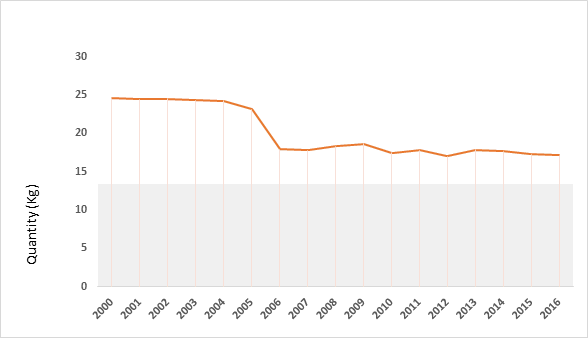
Source: Statistics Canada, Food available in Canada, annual (kilograms per person/ per year)
The Canadian Community Health Survey (CCHS) estimated added sugar consumption in Canada. "Added sugars" includes all sugars, corn syrups, honey, and maple syrup added to foods and beverages. Added sugar consumption in Canada has been declining over the past 20 years, mainly reflecting a decline in soft drink consumption. It does not include sugars that naturally occur in fruits, vegetables, and dairy products. It is estimated that Canadians consume approximately 11 per cent of their energy (calories) as added sugars, equivalent to about 53 g of added sugars per person per day. The most recent CCHS study in 2015 also provided evidence that sugar consumption in Canada has been decreasing.
A comparison of US and Canadian sugar consumption of “added sugars” shows that the Canadian level is much lower — about one-third less than US levels, due mainly to lower soft drink intake in Canada (about half of US consumption).
Table 1: A comparison of average sugar consumption in Canada versus U.S.
| Population Average per person per day (Added sugars estimated) | Canada
(CCHS 2004) | US
(NHANES 2003-04) |
| Total Calories | 2073 Calories | 2195 Calories |
| Total sugars (grams) - natural and added | 110 g | 133 g |
| Added sugars (grams)* | 55 g | 88 g |
| Added sugars (Calories) | 220 Calories | 352 Calories |
| Added sugars (tsp) | 13 tsp | 21 tsp |
| Added sugars (% Calories) | 10.7% | 15.9% |
*Added sugars estimates:
Source: The Canadian Sugar Institute. 2017
The health risk factors related to sugar, such as diabetes, obesity and tooth decay, often occur because of overconsumption. Health Canada has attempted to help consumers control their sugar intake through The Food Guide by suggesting limiting foods and beverages high in calories, fat, sugar, or salt (sodium). The new Canadian food labelling standards also have intended to improve consistency by adding a percentage daily value for sugar. However, taking responsibility of one’s own food intake and consuming sugar in moderation may benefit consumers in many ways.
The Sugar Industry In Alberta and Canada
The first Canadian sugar refinery was established in 1818 in Halifax, Nova Scotia. Even though the demand for a domestic sugar industry was growing, the Halifax refinery was unable to stay in business. In 1854, a new refinery was established in Montreal. The arrival of the Canadian Pacific Railroad on the West Coast opened an opportunity for the sugar industry out west and a refinery was established in Vancouver in 1890 to serve Canada’s growing western market. Around the same time, the first attempt was made to establish a sugar beet industry in Canada. Sugar beets were successfully grown in Ontario and Quebec for many years. However, the Prairie Provinces proved to be ideally situated, inland from cane refineries, providing the economic incentive for a viable beet sugar industry in Alberta and Manitoba. Later, in 1912, the St. Lawrence Seaway’s opening led to the establishment of cane refinery in Toronto.
Canada only has a relatively small domestic sugar industry and imports the majority of its domestic requirements in the form of raw cane sugar. The raw sugar is processed by portside refineries located at Montréal, Toronto and Vancouver. These three refineries supply over 90 per cent of Canadian consumption. Sugar beets are grown in Ontario and Alberta. Ontario production is directly exported to U.S. for processing and is marketed in the U.S.
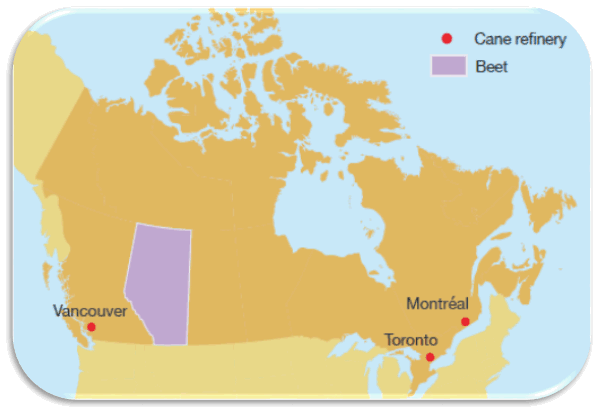 Source: AB Source: AB
Sugar; An Introduction to Global Sugar Market, 2017
In 1950, the Rogers Company established the beet sugar refinery plant in Taber, Alberta. In 2008, Rogers merged with Lantic Sugar to form Lantic Inc. One hundred per cent of Alberta’s sugar beets are processed in the Taber refinery. This plant produces granulated and liquid sugar (pure sucrose) and specialty sugar (icing sugar). Sugar beet processing by-products such as leaves and tops are used to feed local livestock. Sugar beet pulp is used to produce a highly nutritious animal feed or can be further processed for use as fibre. The Taber plant produces about 100,000 tons of sugar per year, which is about 10 per cent of the total Canadian sugar production. The plant mainly supplies the Western Canadian market.
Alberta’s sugar beet industry is unique and sustainable, despite Canada’s intensively competitive market. Being about 1,200 km on the opposite side of the Rockies from the Vancouver refinery, and about 4,000 km from refineries in Montréal and Toronto, increased transportation costs provides for a small market niche in the local market for this operation.
Figure 3: Sugar products from the Taber plant carry a special seal containing a series of numbers starting with 22.
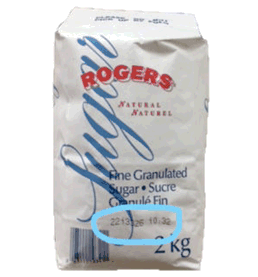
After Rogers and Lantic merged, the production from Taber was packed with a black seal beginning with the digits 22. In Alberta, Rogers sugar packages with a seal number starting with “22” is a local product. At a time when consumers are increasingly demanding local products, Taber’s sugar can be promoted as a local product. This could greatly benefit not only Lantic, but more than 200 sugar beet growers in Alberta.
References
The Canadian Sugar Institute. Retrieved from http://www.sugar.ca/Home.aspx
Statistics Canada. Food Available in Canada, Annual. Retrieved in October, 2017.
M. Garner. Personal Communication. October 10, 2017. Executive Director, Alberta Sugar Beet Producers.
Statistics Canada. Canadian Community Health Survey- Nutrition: Nutrient intake from food and nutritional supplements. Retrieved from http://www.statcan.gc.ca/daily-quotidien/170620/dq170620b-eng.htm |
|